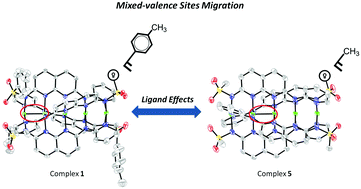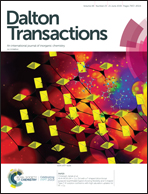Ligand effects on the structure, mixed-valence sites and magnetic properties of novel pentanickel string complexes†
Abstract
We report the syntheses, characterization, electronic structures and magnetic properties of four redox pairs of novel nickel-extended metal-atom chain (EMAC) complexes containing pyridine-, naphthyridine- and sulfonyl-containing ligands (H2Tspnda and H2Mspnda) (1–2 and 5–6). We further study the corresponding phenyl-substituted ligands (H2Tsphpnda and H2Msphpnda) (3–4 and 7–8) to examine the details of ligand effects. The X-ray structure of one-electron-reduced [Ni5]9+ complexes shows shorter Ni–Ni bond distances (2.2646(6) for 1, 2.2943(7) for 3, 2.2436(11) for 5 and 2.2322(8) Å for 7) in comparison with an average Ni–Ni distance of 2.3187(8) Å for these complexes, indicative of a partial metal–metal bond interaction in the mixed-valence [Ni2]3+ (S = 3/2) unit. The most striking result is that the [Ni2]3+ site migrates from Ni(1)–Ni(2) to Ni(2)–Ni(3) when we replace the p-tolyl-sulfonyl group with methyl-sulfonyl group. These complexes present a rare example of the effect of crystal packing on the symmetric molecular structure yielding unsymmetric electronic distribution. Cyclic voltammetry measurements show four reversible redox waves and display the lower potentials of the [Ni5]9+ complexes. These unusual lower potentials facilitate one-electron oxidation of these four complexes to [Ni5]10+-core forms. We applied the magnetic susceptibility and EPR measurements to examine the magnetic properties of these four [Ni5]9+-core pentanickel complexes and study the bonding nature of these mixed-valence [Ni2]3+ units. Indeed, the results of EPR measurements reflect the migration of the mixed-valence site and the change of symmetry. Surprisingly, the oxidized [Ni5]10+ counterparts behave differently: complex 2 exhibits an antiferromagnetic interaction with J = −13.59 cm−1 between the two terminal Ni ions, while the others (4, 6 and 8) display diamagnetic properties as all of the Ni2+ ions are in low-spin (S = 0) states. These three complexes, to the best of our knowledge, are the first examples of all Ni2+ ions in a null spin configuration for pentanickel chains. Even though the structures of these complexes are similar to each other, their corresponding electronic structure and oxidized products show drastic changes in their magnetic properties and bonding nature. These differences of the properties and bonding nature of these pentanickel complexes are attributed to the ligand effects.



 Please wait while we load your content...
Please wait while we load your content...